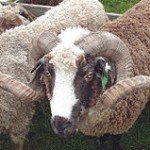New Zealand farmers stand to gain $52 million over the next five years from scientific innovation which has given a local company a signficant lead in screening sheep for potentially profitable genetic gains, says a senior researcher, John McEwan, who estimates another $26 million of off-farm benefits will also be earned.
 Depending on short and longer-term changes in farming, the technology could increase the rate of genetic gain by between 40 percent and 100 percent over existing levels.
Depending on short and longer-term changes in farming, the technology could increase the rate of genetic gain by between 40 percent and 100 percent over existing levels.
Dr McEwan, a senior scientist at AgResearch’s Invermay campus, helped pioneer creation of high-density “SNP chips” and their use to allow faster genetic improvement in sheep, via a technique called whole genome selection. SNPs (single nucleotide polymorphisms) are point mutations or genetic variations, and global researchers this week published work which validated use of such chips to screen animals commercial traits. Parts of a ram’s DNA can be checked against a 50,000 SNP chip to predict, for instance, whether its offspring’s meat is going to be tender or tough or juicy or dry.
“The total industry value of Ovita Sheep50K technology adoption by breeders within the next 5 years is estimated to be worth $52 million to the New Zealand industry,” Mr McEwan told the SMC. “This value has been calculated by assessing the likely adoption rates of the technology for a range of New Zealand sheep breeder types, with the industry value corresponding to each breeder group increasing from $0.5-1 million from adoption in 2011 to $4-5 million from adoption in 2015. The net discounted benefits have been estimated at $38 million after allowance for test costs”.
“In reality, this is only the on-farm benefits, the off-farm benefits are approximately another 50 percent on top of the on farm benefits. The value also depends critically on the adoption rate and conservative values were used. If the costs of the tests keep declining, adoption could be much faster”.
NZ taxpayers have invested nearly $14.6 million over six years in Ovita Ltd — a genomics research consortium made up of state science company AgResearch Ltd and industry board Beef and Lamb NZ– to develop genomic and diagnostic selection tools targeting genes controlling traits such as coat colour, body size, and reproduction. Mr McEwan said that ideally there could eventually be gains in resistance to disease and parasites.
Mr McEwan — made a Fellow of the Royal Society of New Zealand last November — responded to questions from the SMC:
How has taxpayer funding supported the global genomics paper and Ovita’s plans to develop genomic and diagnostic selection tools?
“Ovita investment underpinned the initial sequencing and creation of the SNP chip used in this and Ovita’s studies. The results from the HapMap project can be and are used in Ovita’s work. For example the genotyping done allows us to identify the ancestral alleles (variants) in sheep and that is used routinely in mapping studies.”
How do traits/SNP regions with potential economic benefit to NZ farmers align with the regions of the genome which the global genomics study canvassed?
“Ovita has developed tests for horns and this region maps directly to a region described in this study. The muscling region was also detected in Texels. Both of these were tests developed by Ovita and marketed before this study. In other regions there is some overlap but most of the genomic selection tests now use information mapped from the entire genome, not specific regions.”
How are knowledge gains in this area being translated into commercial innovations for the wider economy?
“Genomic selection is now widely used in the NZ dairy industry following sequencing of the bovine genome and development of a snp chip. This study is part of the equivalent process in sheep. Similar studies and applications have occurred in pigs and chickens and very similar approaches now are being used in a wide variety of plant species. In the context of New Zealand: Plant and Food have done nearly identical work in apples for instance.”
Did taxpayer funding help create fundamental knowledge underpinning the science which will be directly translated into commercial gains?
“This work was international in scope. NZ funding was around 50 percent taxpayer funding and 50 percent industry funding. Quite a bit of the benefit is captured by taxpayers. However, the typical problem is industry usually wants to fund research that will deliver a benefit within a 5 year term. For longer term and generally more diffuse benefits taxpayer investment is a better option.”